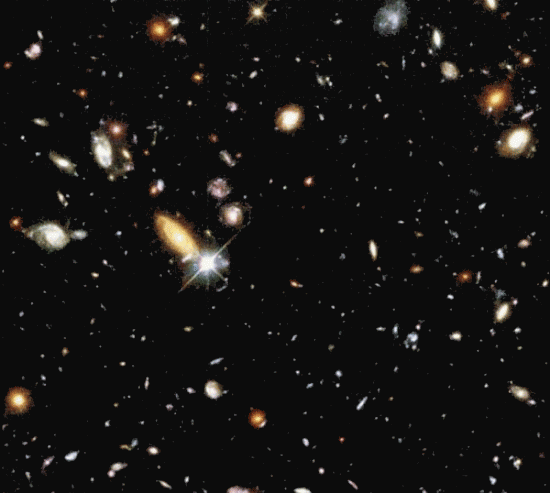
A detail from the Hubble Ultra Deep Field image.
Credit: NASA, ESA, S. Beckwith (STScI) and the HUDF Team
Original Post August 3, 2012
A new theory states that dark matter might prevent stars from aging normally and preserve them for billions of years.
According to astronomers, the Universe is almost 14 billion years old. It started out with a bang – an explosion occurred and all of existence came into being. Scientists do not know why or how space, time, energy and matter were created in the so-called Big Bang, but they speculate that within the first second protons, neutrons and electrons condensed from a sea of undifferentiated interactions.
When the Universe began, as the theory states, it was approximately 10^32 Kelvin, far too hot for any atoms or molecules to be present. Three minutes later, the temperature had fallen to one billion Kelvin and the proto-atomic particles formed the first nuclei that would eventually become atoms.
The next major change in the development of the Universe came about after another 300,000 years when it cooled down to 3000 Kelvin, permitting electrons to orbit those initial protons and form atomic hydrogen. As the cooling period continued the temperature gradually fell to a point where atomic hydrogen was able to combine into molecular hydrogen and begin transforming into the structures and objects visible today.
Stars born in that early period were so hot and dense that they lived for a mere 100,000 years, consuming their hydrogen and fusing it into helium and other heavier elements. According to the Paris Institute for Astrophysics, however, some of those early stars might actually still exist within our own Milky Way galaxy. The preserving factor? Dark matter might have dampened stellar fusion to such minimal activity that the aging process of those stars was suspended and they stopped evolving.
The original stars are known as population III stars and many of them could have formed within vast clouds of dark matter that preserved them for a practical eternity. According to Gianfranco Bertone of the Paris Institute: “These stars can be frozen for timescales longer than the age of the universe.”
If dark matter particles called Weakly Interacting Massive Particles (WIMPS) are made from heavier versions of normal matter, they might be drawn down to stellar cores through gravitational attraction. The dark matter could then act like other thermonuclear phenomena and undergo violent collisions with normal particles, emitting radiation and elementary fragments that appear to be based on conventional theories of stellar evolution. Dark matter would put a halt to nuclear fusion and “freeze” the star in its aging process for hundreds of thousands of years. Once the dark matter was burned up the star would then go back to fusing hydrogen into helium as prevailing theories assert.
Bertone’s research team speculates that if the first stars ignited near galactic cores where dark matter is unusually dense they might have been preserved indefinitely: “There could be conditions in the early universe where stars form in big enough reservoirs of dark matter to last until the present day.”
Indeed, dark matter might have the ability to bring dead stars back to life. If a white dwarf (the supposed husk of a yellow star like the Sun) entered a dense dark matter cloud, it might actually begin to burn dark matter and start to shine as if it were a white star. Some researchers suggest they could become many times brighter than before.
Building a theory on another theory and relying on the conclusions of one speculation to prop up the conclusions of another is tantamount to science fiction. In the case of “dark matter burners” and stars almost as old as the Universe we are dealing with a step-by-step descent into sheer irony.
Since dark matter is unseen and undetectable and has been inferred from mathematical manipulations, could it be that something else is taking place? From the perspective of the Electric Universe theory galaxies and stars are all driven by electric currents flowing through dusty plasma.
Birkeland currents create Bennett pinches in electrical vortices where compressed plasma forms glowing spheres – most in arc mode but some perhaps remaining in a dark mode discharge state. As mentioned in previous Picture of the Day articles, dark matter is an ad hoc addendum that is designed to protect the Big Bang theory.
Plasma theorists have grown weary of mathematical legerdemain and are waiting for cosmologists to start thinking about empirical observations rather than continuing on this path toward mysticism. Dark matter (and by extension, dark energy) has been imbued with powers and abilities far beyond the scope of experimental research. The case for dark matter can be thrown out if electricity is considered a formative factor in what has been observed in space.
Stephen Smith












